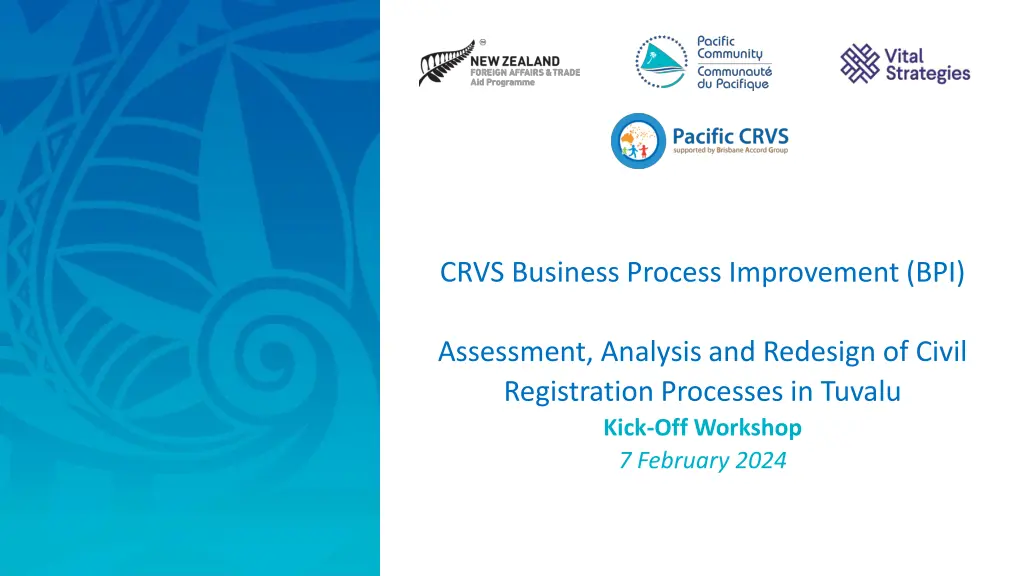
Improving Civil Registration Processes in Tuvalu - BPI Assessment
Enhance Civil Registration processes in Tuvalu through BPI Assessment, Analysis, and Redesign for continued improvement. Establish current system understanding, identify performance gaps, and develop redesign ideas. Engage stakeholders, implement Mortality Reporting, and focus on CRVS Strengthening. Objectives include improving customer service, identifying bottlenecks, reducing costs, and fostering collaboration. Senior Advisor and National Coordinator lead the project implementation with stakeholder mapping. Methodology includes a multi-sectoral participatory approach within the CRVS system Improvement Framework.
Uploaded on | 0 Views
Download Presentation

Please find below an Image/Link to download the presentation.
The content on the website is provided AS IS for your information and personal use only. It may not be sold, licensed, or shared on other websites without obtaining consent from the author. If you encounter any issues during the download, it is possible that the publisher has removed the file from their server.
You are allowed to download the files provided on this website for personal or commercial use, subject to the condition that they are used lawfully. All files are the property of their respective owners.
The content on the website is provided AS IS for your information and personal use only. It may not be sold, licensed, or shared on other websites without obtaining consent from the author.
E N D
Presentation Transcript
CRVS Business Process Improvement (BPI) Assessment, Analysis and Redesign of Civil Registration Processes in Tuvalu Kick-Off Workshop 7 February 2024
BPI BPI - - What is it? What is it? Aim: Assess, analyze and redesign the birth and death registration processes to guide continued CRVS improvement efforts Objectives 1. Establish a detailed understanding of how the current CRVS system and its business processes by producing detailed descriptions and maps 2. Identify any gaps between the current performance of the system and the desired performance targets 3. Develop redesign ideas to improve the CRVS system, based on identified performance issues
A two-part project 1. Mortality Reporting and Coding Formation of Technical Working Group Two medical practitioners to Tonga late April with local training July/August Two ICD coders to Fiji with regional pilot July/August CRVS Strengthening Business Process Improvement Action Plan CRVS Committee? 2.
Aims of Business Process Improvement Aims of Business Process Improvement To improve customer service/experience Identify bottlenecks and improve efficiencies Reduce operational costs Align stakeholders to work together as a group Develop new interventions or systems
What is needed to implement? What is needed to implement? CRVS stakeholders from relevant ministries, departments or agencies The following experts have been engaged : Senior Advisor: responsible for providing technical guidance and overseeing the project (Jeff Montgomery) National Coordinator: responsible for ensuring the project is efficiently implemented in-country, in coordination with local stakeholders (Teresa Lifuka-Drecala)
Stakeholder Mapping Stakeholder Mapping 1. CRVS is a eco-system no one agency can achieve alone 2. Have we got the right people in the room government and customer perspectives? 3. To building a sense of ownership for the next steps, who do we need to keep informed?
Methodology Methodology Stage 1 of the CRVS system Improvement Framework will be used as the main methodological guide . Applies a multi-sectoral, participatory approach to continually improving the CRVS system. Introduces systems thinking tools such as process mapping as a key strategy to engage stakeholders, improve understanding of the system and its weaknesses, identify solutions and monitor change. Group and/or individual consultations with relevant CRVS stakeholders will be used to collect necessary information.
Implementation Steps Implementation Steps Redesign Analyse Identify redesign ideas Develop As-desired business process maps Develop an Action Plan Assess Identify performance issues and bottlenecks Analyse root causes of issues Document CRVS business processes Develop As-is process maps Identify Key Performance Indicators (KPIs)
Consultations Consultations Extensive group consultations with members of the Core Team of CRVS Stakeholders Additional online/in-person consultations as needed with CRVS stakeholders Findings presented at 2 days' workshop
Example process map: Registration of birth at home Example process map: Registration of birth at home
Timeline for Implementation Timeline for Implementation Project Duration: 3 months (approx.) April 2024 Stage 2 Launch of project Kick-off workshop Develop descriptions and maps for As-is civil registration processes Develop redesign ideas and improvement policies Approval of redesign ideas by core team Finalization of report High-level presentation In-person workshop 2-days April 2024 Review of KPIs Calculation of baseline data Target setting Analysis of current processes June 2024 February 2024 Stage 3 Stage 1
Possible Outcomes Possible Outcomes Support and streamline the rollout of a digital CRVS platform Identification of performance issues and bottlenecks can inform system enhancements, for more efficient business processes. Relevant for digital CRVS systems that are still in the design phase and those that are already being rolled out. Informing the development or redesign of national CRVS policies Findings from the assessment, analysis and redesign of current business processes can inform evidence-based policy-making, including the development and redesign of a national CRVS policy and/or standard operating procedures (SOPs). Quick win solutions Although the main aim of CRVS-BPI activities is to support longer-term, sustainable system strengthening, the results may also inform short-term solutions which aim to reduce the burden on clients e.g. re-designing registration forms, reducing the amount of supporting documentation needed, public awareness campaigns etc.
